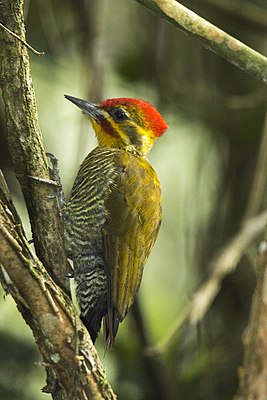White-browed woodpecker
| White-browed woodpecker | ||||||||||||
|---|---|---|---|---|---|---|---|---|---|---|---|---|

White- browed Woodpecker ( Piculus aurulentus ), male |
||||||||||||
| Systematics | ||||||||||||
|
||||||||||||
| Scientific name | ||||||||||||
| Piculus aurulentus | ||||||||||||
| ( Temminck , 1821) |
The white- browed woodpecker ( Piculus aurulentus ) is a bird from the family of the woodpeckers (Picidae) found in South America . The specific epithet is derived from the Latin words aurum for 'gold' and the suffix -lentus for 'abundance' and refers to the striking golden yellow throat of birds. The German trivial name is based on the whitish over-eye stripe .
features
White-browed woodpeckers reach a body length of 21 to 22 centimeters and a weight of up to 68 grams. There is a slight sexual dimorphism between the sexes . In the males the top and back of the head and the border of the throat are colored in a strong red, in the females this color appears on the back of the head. In both sexes the throat is golden yellow, the stripes above and under the eyes are yellowish to whitish, the reins are olive green. The birds also have olive-green wings and dorsal plumage of the same color. The chest and stomach area are olive brown and pearled white . The long, dark green control feathers are wedge-shaped and serve as a support when they move on tree trunks. The bill is slate gray, the iris is reddish brown. Legs and feet are greenish gray.
distribution and habitat
The white-browed woodpecker occurs in the south-east of Brazil , in the east of Paraguay , in the north-east of Argentina and recently also in the far north of Uruguay . The main habitat of the species are moist mountain forests, forest edges and moist woodland in the plains. It is considered to be loyal to the location. The altitude distribution in Brazil reaches up to 2000 meters.
Way of life
The birds, which live singly or in pairs, feed primarily on ants and beetles and their brood, which are sought on the ground or in rotted wood. Fruits are sometimes accepted as a dietary supplement. Gross activities were observed in Brazil between August and November and in Argentina in September. The typical woodpecker nest is carved into a tree trunk at heights of up to 7.0 meters. Further details on the breeding behavior have not yet been documented.
Danger
The white-browed woodpecker is in decline in some of its habitat areas due to the reclamation of its habitats and is therefore classified by the IUCN as ![]() “ near threatened ”.
“ near threatened ”.
Etymology and history of research
Coenraad Jacob Temminck described the woodpecker under the name Picus aurulentus . He stated Paraguay and Brazil as the place of discovery. Johann Baptist von Spix had introduced the new genus Piculus as early as 1824 . Only later was the white-browed woodpecker assigned to the genus. "Piculus" is the Latin word for "little woodpecker". "Aurulentus" is derived from the Latin "aurum" for "gold" and means "gold-colored".
Individual evidence
- ↑ a b c d H. Winkler, DA Christie & A. Bonan (2017). Yellow-browed Woodpecker (Piculus aurulentus). In: J. del Hoyo, A. Elliott, J. Sargatal, DA Christie & E. de Juana (eds.): Handbook of the Birds of the World Alive. Lynx Edicions, Barcelona. (viewed at http://www.hbw.com/node/56261 on July 16, 2017)
- ↑ dissemination
- ^ IUCN Red List
- ^ Coenraad Jacob Temminck, p. 39, plate 59, figure. 1.
- ↑ Johann Baptist von Spix, index of contents p. 3.
- ↑ James A. Jobling, p. 306.
- ↑ James A. Jobling, p. 62.
literature
- Josep del Hoyo , Andrew Elliott, Jordi Sargatal: Handbook of the Birds of the World, Jacamars to Woodpeckers. Volume 7, Lynx Edicions, 2002, ISBN 978-84-87334-37-5 .
- James A. Jobling: Helm Dictionary of Scientific Bird Names . Christopher Helm, London 2010, ISBN 978-1-4081-2501-4 .
- Coenraad Jacob Temminck: Nouveau recueil de planches coloriées d'oiseaux: pour servir de suite et de complément aux planches enluminées de Buffon (plate 66, figure 2 & text) . tape 4 , delivery 10. Legras Imbert et Comp., Strasbourg 1821 ( biodiversitylibrary.org ).
- Johann Baptist von Spix: Avium species novae, quas in itinere annis MDCCCXVII-MDCCCXX per Brasiliam jussu et auspiciis Maximiliani Josephi I. Bavariae Regis Augustissini suscepto colleoit et descripsit . tape 1 . Impensis editores, Munich 1824 ( biodiversitylibrary.org ).
Web links
- Piculus aurulentus inthe IUCN Red List of Threatened Species 2017.1. Posted by: BirdLife International, 2016. Retrieved August 20, 2017.
- BirdLife International: Species Factsheet - Yellow-browed Woodpecker ( Piculus aurulentus ) . Retrieved August 20, 2017.
- Videos, photos and sound recordings of Yellow-browed Woodpecker (Piculus aurulentus) in the Internet Bird Collection
- White- browed woodpecker ( Piculus aurulentus ) at Avibase; accessed on August 20, 2017.
- Piculus aurulentus in the Integrated Taxonomic Information System (ITIS)
- xeno-canto: Sound recordings - Yellow-browed Woodpecker ( Piculus aurulentus )
- White- browed woodpecker (Piculus aurulentus) in the Encyclopedia of Life . Retrieved August 20, 2017.
Remarks
- ↑ Spix assigned the bronze woodpecker ( Piculus chrysochloros Vieillot , 1818) (Syn .: Piculus macrocephalus Spix , 1824), the spotted- breasted woodpecker ( Colaptes punctigula guttatus ( Spix , 1824)), the yellow- browed woodpecker ( Melanerpes cruentatus rubrifrons , 1824) ( Spix )) to the genus , the yellow-throated woodpecker ( Piculus flavigula erythropis ( Vieillot , 1818)) = (Syn: Piculus icterocephalus Spix , 1824), the golden-eared woodpecker ( Veniliornis maculifrons ( Spix , 1824)) and the blood-winged woodpecker ( Veniliornis affinis ruficeps ( Spix , 1824)). He only used the name Piculus in the table of contents. In the descriptions he assigned the woodpeckers to the genus Picus .
